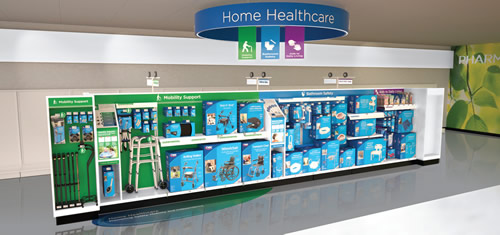Business Solutions
Retail: Having the Right Plan
As providers increasingly add retail sales to their revenue mix, planograms become an essential tool. What makes a effective planogram and how can providers use them strategically?
- By David Kopf
- Sep 01, 2018
 Retail is a critical component of HME provider revenues these days, and because of that, providers are becoming far more strategic in how they approach retail sales. And a key element a smart retail strategy is having a showroom that does the selling. A provider can employ only so many people, so it is essential that the store is organized and goods are presented in such a way that shoppers can find what they want, are enticed by other items, and can make an informed selection in instances when staff members are already helping other customers.
Retail is a critical component of HME provider revenues these days, and because of that, providers are becoming far more strategic in how they approach retail sales. And a key element a smart retail strategy is having a showroom that does the selling. A provider can employ only so many people, so it is essential that the store is organized and goods are presented in such a way that shoppers can find what they want, are enticed by other items, and can make an informed selection in instances when staff members are already helping other customers.
Planograms can help accomplish that. Long an asset of other retail industries, planograms help retailers organize what’s on their shelves to help promote and sell their wares. Over the past several years, vendors and distributors of HME have been supplying planograms to their provider customers in hopes of helping them excel and retail sales. HMEB sat down with a couple retail experts, Mike Scarsella, national sales director for Compass Health, and Rob Baumhover, director of VGM Retail and Vendor Programs, to get their take on how providers can use planograms strategically.
HMEB: What is a planogram and how does it work? What’s its function?
Mike Scarsella: A planogram would be a pre-merchandise grouping of products that are merchandised together in terms of price point, in terms of category, in terms of function, but also in terms of display. So, they’re merchandised together, but they’re also grouped together in a prepackaged presentation. The purpose, generally speaking, of a planogram would be to make things easy and simple and take some of the guesswork out of the dealer’s responsibility and make their life a little bit easier. In places that the focus from the experts of a particular category or product line being the vendor or manufacturer.
Rob Baumhover: Derived from research and data related to consumer buying habits and trends, a planogram shows the layout, set-up, recommended product SKUs and quantities for a given product category a manufacturer has put together.

Planograms have come a long way from the very simple, two-dimensional line drawing diagrams of how providers should organize products on a shelf. Now there are very photorealistic, three-dimensional computer designs that give providers very clear ideas of how DME could look on a shelf.
HMEB: How important are planograms in terms of retail strategy? How can this help an HME provider?
Baumhover: Planograms are great for certain categories (incontinence, wound care, compression and bracing) or categories where a provider uses only one manufacturer per section or category. However, where categories vary more (fitness, pain management, daily living) then a provider should be creating merchandising plans using multiple manufacturers or products to get a healthy mix of product to satisfy the market or customer base.
Scarsella: It’s important that the planogram doesn’t supersede the product itself, making sure that the product is right — right for the market, right for the particular dealer. So all of that still has to come into play, but the planogram is important for a dealer in the sense that it can get them to the point of presenting their products to their customer base and consumer base much faster and much easier, much more consistent and streamlined. It allows them to manage their inventory much better. It takes a lot of the guesswork out of that in terms of stocking inventory, reorder points, minimums, maximums. A lot of that is built into most planograms, so again, the guesswork comes out of it. It becomes pretty straightforward. So they are an important tool, especially as our industry expands and continues to explore deeper the cash retail side of the business. Planograms and presentation is something that is common in the general retail world, so it’s relatively new to the HME side of things, but it’s an important part of merchandising, especially on the cash retail side, for sure, for dealers.
HMEB: Can planograms help both retail and funded goods?
Scarsella: Absolutely. Obviously, many of the products that might be included in a planogram for bath safety, for example, or mobility, are products that do have HIPAA codes that are part of a Medicare reimbursement program or are covered by insurance. It’s a way to present those products to the customer base and have the insurance coverage of the funding just be part of the end of the interaction. How are we going to get this paid for? Is it going to be cash, check, credit card, Medicare, Medicaid, insurance? Additionally, planograms can assist in the ever-increasing need for complementary products, bundle selling, and add-on sales that help retailers compensate for lower reimbursement situations. So somebody could come in for a funded product and provided the product, and then the planogram on the cash retail side provides a quick and easy presentation of products that can be purchased directly with cash in addition to the funded item that allows for that consumer to leave with a better experience, better product, more independence, whatever the case may be, but also gives the dealer a chance to easily bundle products together with the funded products and maximize that interaction from a financial standpoint with the consumer.
HMEB: What makes for an effective planogram? What are some components that can help a planogram help the provider do the selling?
Scarsella: I think, in a lot of cases, the visual nature of a planogram is important. It needs to present well. It needs to make sense logically for the consumers, easy to understand, easy to find the products, easy to navigate from one side to the other and find exactly what they’re looking for. It should take into account light products and complementary products. It should include silent sales pieces and aisle interrupters and the right signage so that it is communicating effectively in line with the dealer’s business model. A lot of things go into it but the visual nature of our planogram is very important. The ease of replenishment is a significant part of it as well, not only from the ordering and buying side, but also from the physical stocking side of making sure that it’s up to date.
Baumhover: An effective planogram consists of a good product assortment within the category. In addition, it should include an attractive layout and retail packaging. Lastly, it should have relevant branding materials like sample store signage, displays for the customers to feel the product, and related marketing messaging.
HMEB: When do providers change their planogram? Do they wait for sales to taper or do they change them up on a seasonal basis to keep things interesting? Or is it even necessary?
Baumhover: Semi-regularly all stores should initiate a nice refresh to help reenergize their customers around their store offerings. This refresh should include simple layout changes, conversion of product, bringing in new product, etc. Outside of these changes, to understand if a planogram needs updating, a provider will need to determine the successfulness of a planogram through sales reports, customer feedback and changes in the marketplace.
Scarsella: I think it really depends upon the products that you’re talking about at a particular dealer. There are going to be some products that don’t change very often. In those cases, it’s your mobility, your bath safety, some of the products that are going to be all year round. They’re not subject to seasonality. The needs that the consumer base has every single day as they walk in, and from there, the evaluation of the planogram, in my opinion, is going to be purely driven by the performance of individual SKUs. Is it maximizing the dollars per square foot? The space that it’s taking up, should we look at maybe doing a four-foot instead of the eight-foot? It’s driven by performance. It’s driven by sales. In other cases, some of the products might be more seasonal. They might be more geared towards the holiday season. There are some things out there that we see spikes during Mother’s Day, Father’s Day, and certain holidays. Those planograms can be either remerchandised around those times or adjusted down during the down times or simply moved to a different part of the store so they’re more featured.
HMEB: What’s the uptake among providers when it comes to planograms? Are providers seeing the benefit of planograms and integrating them into their merchandising?
Scarsella: I think they are. I think they are when the planogram itself and the program surrounding the planogram and the economics are right. I think the retailers, as we know, are already good at their business. Putting a planogram in just for the sake of a planogram doesn’t make any sense but they’re absolutely willing to accept the opportunity to make their life easier if the planogram itself meets the expectations and is presented in such a way that it will. Do I see HME retailers that are one planogram from one side to the other? No, but I also don’t think planograms are necessarily right for every product line and product group. But to answer your question, we’re seeing more and more of them where it makes sense, but really the dealers are wide open to any assistance and any help. Planograms fit into that but it has to make sense. It has to be the right product. It has to be displayed the right way, and ultimately, the economics in terms of selling price and margin and inventory carrying costs.
HMEB: How do providers get started with planograms?
Scarsella: I think it really comes down to asking the question of their vendor reps and their suppliers. Do you have any kind of pre-merchandise programs that would help me with this particular part of my store in terms of actual planograms or any groupings of products that aren’t necessarily planogrammed out completely, but the thought process has gone into it already. It’s just opening up the dialog. “Ask your vendors” is a common theme I talk to dealers all the time about. They’re the experts. Use them. Take advantage of the years of experience, the knowledge, the fact that they’ve got data from many, many other HME dealers across the country that all can be used to help your business. So if you’re trying to figure out how you can make your merchandising of your showroom a little bit easier, just ask the questions: What do you guys have that is prepackaged? Do you have any planograms? Do you have anything that can help with this space? How much do you need and let me take a look.
Baumhover: Customers are looking for a clean store that is easy to navigate and shop. Planograms can create just that. To effectively implement a planogram, first choose the best planogram to fit your space. If needed, see if your vendor will help make the planogram attractive to your store. To best rollout a planogram, make sure to request that all resources for training your employees are available. Then after implementation, regularly check your reports to determine the successfulness of the planogram and related product offerings.
This article originally appeared in the September 2018 issue of HME Business.